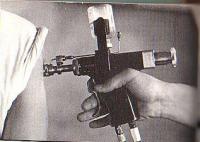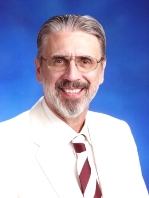Gunned down in basic training
 www.hcvets.com
www.hcvets.com
Richard Darling, DDS, recounts how air gun vaccinations spread hepatitis C to many Vietnam era soldiers, his experience as the recipient of a life-saving liver donation, efforts to reform organ donation laws and why more equitable distribution of disease research funding is needed.
by Dr. Richard Darling, DDS
Of course all those shots you got while in the service were meant to protect you from some really bad diseases. Unfortunately, there were some unexpected consequences caused by the method of injection. The air-gun was deadly on diseases, but now we know it also (unknowingly) helped at least one virus spread from person to person to person.
Has it really been over 40 years since we formed a long line of new recruits at Fort Dix and other basic training camps to get our air-gun vaccinations? Yes, and I’m sure you also remember that at times there was blood rolling down a fellow trainee’s arm at the injection site. The medic who was doing the injections might clean the gun nozzle with an alcohol gauze pad, but in many instances no cleaning was done at all. Even an alcohol gauze pad does not kill the hepatitis C (HCV) virus, so air-gun injections became the most efficient method known to man of spreading this virus.
 Dr. Richard Darling, DDS
Dr. Richard Darling, DDS
In a study conducted by the Veterans Health Administration, involving 26,000 veterans, up to 10 percent tested positive for HCV. (The government’s estimate for HCV in the general public is 1.6 percent.) Of the total number of persons who had been exposed to hepatitis C, 63 percent were noted to be from the Vietnam era with all other wars each accounting for 5 percent or less.
HCV infection can be serious – however, it should be noted that approximately 75 to 80 percent of those infected with HCV will never progress to severe liver disease, commonly called cirrhosis of the liver, in which the liver becomes scarred from the damage done by the hepatitis virus attacking and killing liver cells.
Nevertheless, if you received the air-gun vaccinations, you should be tested for HCV, and if your results are positive, you should also have a “liver panel” blood test to determine if you have ongoing damage to your liver. Existing drugs to eradicate the HCV virus are effective, on average, in only 50 percent of those who take the treatment. Clearly, better drugs are needed.
Twenty-five years after my Fort Dix air-gun experience I had a blood test for an insurance company, and was told that I had non-A, non-B hepatitis, which is what they called hepatitis C before they identified it with the electron microscope. Five years later I was told that I had liver cancer, and because the organization that oversees all transplants in our country, UNOS (United Network for Organ Sharing), had not given formal approval for transplanting patients with liver cancer, I was scheduled to die. With the common symptoms of liver failure (swollen ankles, confusion from toxins in the brain, fluid-filled abdomen, jaundice, severe fatigue) hobbling me, my wife and I drove to the funeral home and paid for my casket and services.
When the funeral home director handed me the bill, I thought, “Gee, couldn’t you wait for me to die naturally? Are you trying to kill me with a heart attack right now!?” Then he said to my wife, Kress, “We have a special today. Sign up too and get yours for half price.” Gee, what a deal! Kress signed on the dotted line to ensure I would not feel lonely on this momentous day. We purchased our plot in the cemetery and then designed our marker: “Together Forever.”
We subsequently traveled to the cemetery to see my soon-to-be home, a surreal journey to be sure. As I cleaned our marker (hey, I want it clean when I look up at it!), my wife walked a few feet over to the adjacent plot, and with her inimitable sense of humor that kept me going at the most difficult times, she exclaimed, “Look, Sweet heart, you’re right next to Sonny Bono! You’ll get to hear “I Got You, Babe” and “The Beat Goes On” every day for eternity!”
“Egads,” I said laughingly, “I loved Sonny and Cher but give me a break! Every day for eternity?! Please Lord, don’t do that to me!”
I urge patients and their caregivers in my liver disease support group, and in the nearby transplant ICU, to also utilize a regular sense of humor. Laughing makes it easier to stay positive and grateful for yet another day of life, as opposed to the “Why me?” attitude that is so destructive.
When I had only weeks to live, UNOS changed its regulations, and I was blessed with a new liver. Unfortunately, it did not function, and after I woke up from the anesthesia, I looked at my wife as she urged me on, “We’re going to get you through this.” I closed my eyes, drifted into a coma, and then suffered a heart attack.
Mark Antonowitsch was a highly decorated Gulf War veteran with a wonderful wife, Daniela, and three young children – Steven, Daniel, and Christopher. In his last year of law school, Mark and his wife were about to close escrow on their first home when he was mortally injured while driving his motorcycle.
Years before Mark’s accident, his dad, Jim, had found sobriety in Alcoholics Anonymous. To illustrate his gratitude, Jim sold his landscape contracting business, became a treatment counselor, and built the Oasis Treatment Center in Anaheim, California, which to this day has helped over 9,000 patients with substance abuse problems.
When Jim and his wife, Kathy, were notified that their son had been mortally injured, they immediately went to the emergency room. Kathy collapsed upon seeing Mark’s unrecognizably swollen body. Although they were suffering from debilitating sorrow, they agreed to donate Mark’s organs, and with only hours to live, I received Mark’s liver, his “Gift of Life” to me that day allowed me to emerge from my coma.
A few months later I met his parents in a tearful reunion when we “took Mark” to his law school graduation to receive his posthumous degree. Later, I met Mark’s 10-year old son, Christopher, who ran into my arms and said, “Richard, I love you.” Knowing a part of his dad was in me, I believe this was his unique way of hugging his father once again.
I took Christopher to Disneyland, and as we were walking he suddenly stopped, turned, and came close to my face. Christopher asked me a question in a manner that only a child can achieve, and with the use of a word that only a child owns. “What part of Daddy do you have?”
I was shocked. How to respond? Would I upset him? I opted for the truth and said, “I have your dad’s liver. It’s under my rib cage, filters my blood to keep me alive and I’m honored to have it.”
Christopher turned and started to walk again. Whew! I was relieved that such a tender moment was over, but I was wrong. He turned again and this time he really got in my face. I waited for his next words which I knew would make me cry. He spoke with great urgency, “Cool, can we go on the roller coaster now?!”
Since few liver cancer patients had been transplanted in 1998, it was not known if chemotherapy was appropriate post-transplant or if chemotherapy would kill the new liver.
I agreed with my physician’s decision to administer the chemotherapy, but I had cirrhosis again within a year, as well as diabetes and failing kidneys. I returned to the intensive care unit. After three difficult months, God blessed me with a third liver. Understandably, the use of chemotherapy immediately after liver transplant was halted.
When I became ill, I researched how our government spends taxpayer dollars for bio-medical disease research, and found they were spending $2,400 on each HIV/AIDS patient versus $10 on each patient with HCV, and $25 on each patient with diabetes, a disease that kills more Americans each year than AIDS and breast cancer combined. The numbers are now $3,040 for each AIDS patient, and for HCV and diabetes, $25 and $50 respectively. The funding for other illnesses is even more unfair so I founded a national organization, the FAIR (Fair Allocation in Research) Foundation, to correct this situation. FAIR now has thousands of members and supporters in all 50 states.
California is indicative of the great success that has been achieved in the fight against HIV/AIDS. AIDS deaths in that state’s newly infected patients have dropped from just under 10,000 to 118 as of December 31, 2006, yet HIV/AIDS still gets 10 percent of the entire federal research budget. FAIR now has thousands of members and supporters in all 50 states calling for change.
We represent all non-AIDS illnesses, but during my presentations I always mention that there are five times more voters with HCV than with HIV – and that HIV and HCV co-infected patients are now dying more from HCV than they are from AIDS.
I have promoted organ donation all around the country, and have organized a large group of physicians and organ-donor advocates who are calling on UNOS to try new policies to reverse America’s organ donor crisis that now has one person dying every 90 minutes while waiting for a transplant.
For example, the policy of “presumed consent” has been used successfully in over 20 countries, and we also support “donation benefits.” If $10,000 were offered to the families of those who have died to encourage them to allow donation and save a transplant patient’s life, we believe this would dramatically increase the number of lives saved. The money would come from a trust established by insurance companies. Why would they do that? Because it can cost an insurance company up to $300,000 to keep a patient on kidney dialysis. Paying $10,000 would be very cost-effective. With 95,000 sick individuals on the waiting list, and only a few thousand transplanted every year, the need for new policies is urgent.
While I was in my coma, I could sometimes see and hear my nurses, and later wrote a book, Coma Life, about this experience. When I was not watching what was going on around me, I had surreal dreams. In one of these dreams, Dennis Rodman was trying to save my life with blood transfusions. Some might call having Dennis in my coma a nightmare, but I was thrilled to have him with me – and I eventually met him, ironically in the same medical center where he visited me in coma. Dennis was a bit puzzled as I introduced myself and gave him a signed copy of my book in appreciation for trying to save me as I lay dying in my coma life.
Coma Life’s extensive information about liver illness, transplant and life-within-coma has benefited many patients. Some of those patients say, “If Dr. Darling can make it through three transplants – I (or my son, mother, daughter, etc.) can make it through one!” Hope and information is critical to patients, and God has blessed me with the medical history and experience to offer both to the suffering. In my prayers, I thank God for yet another day of life, and I continue to be amazed that, since birth, I have had four livers.
References
Viral Hepatitus, Centers for Disease Control and Prevention
United Network for Organ Sharing
Dr. Richard Darling, DDS, is president and CEO of The FAIR Foundation, a national movement to reverse inequities in research-funding distributions. Joining FAIR is free. His book, Coma Life, is available at www.comalife.org.



 del.icio.us
del.icio.us Digg
Digg












Post your comment